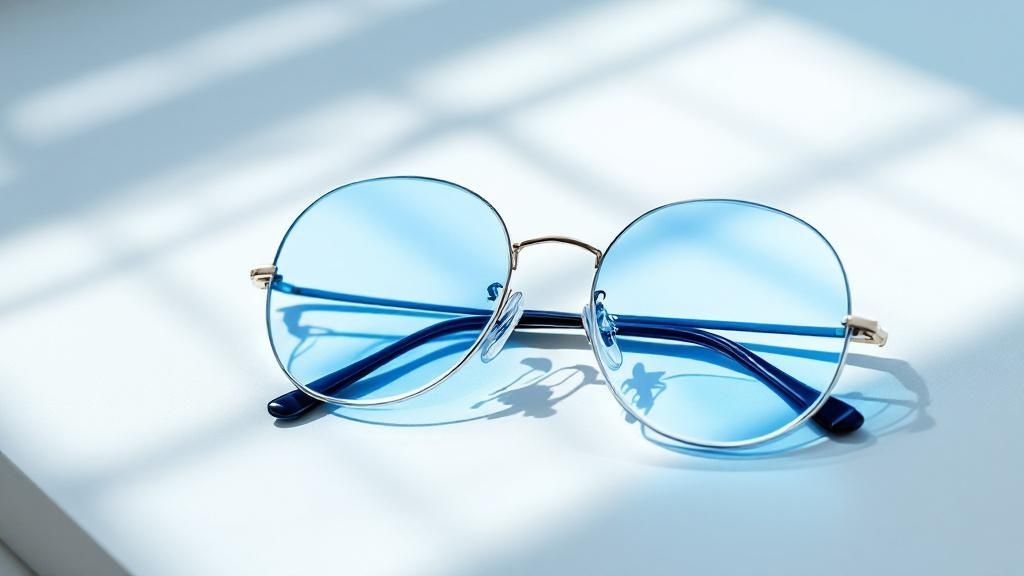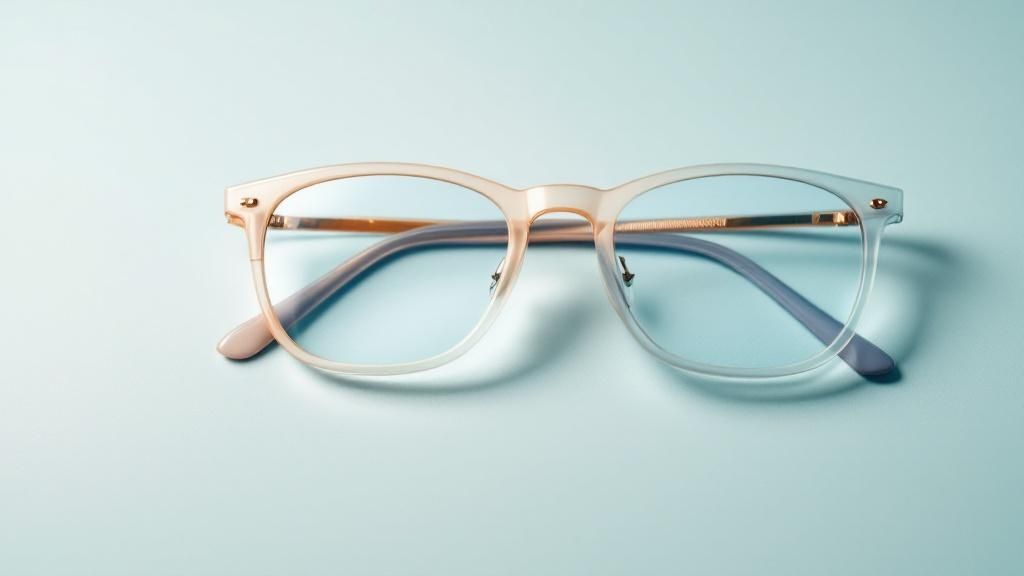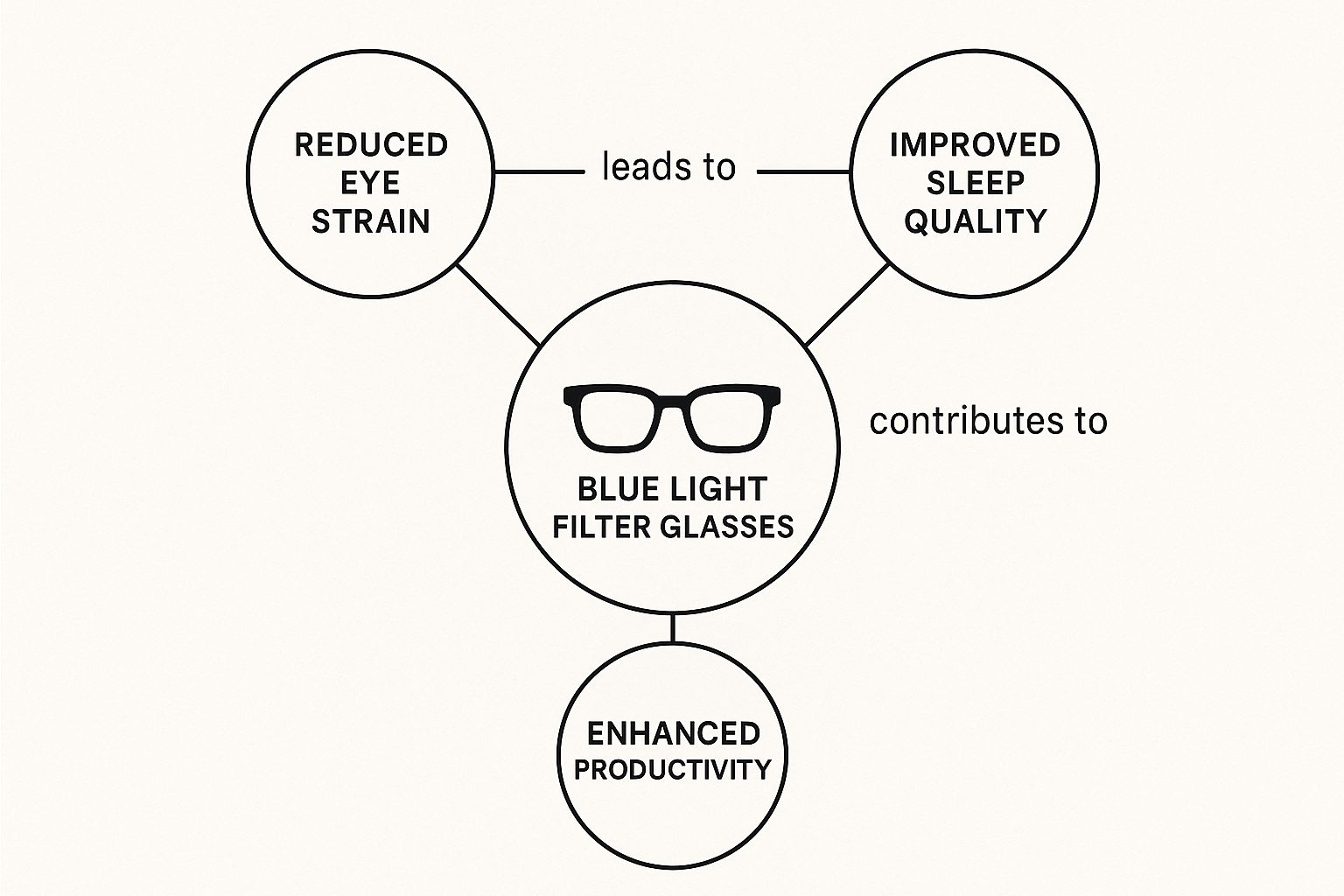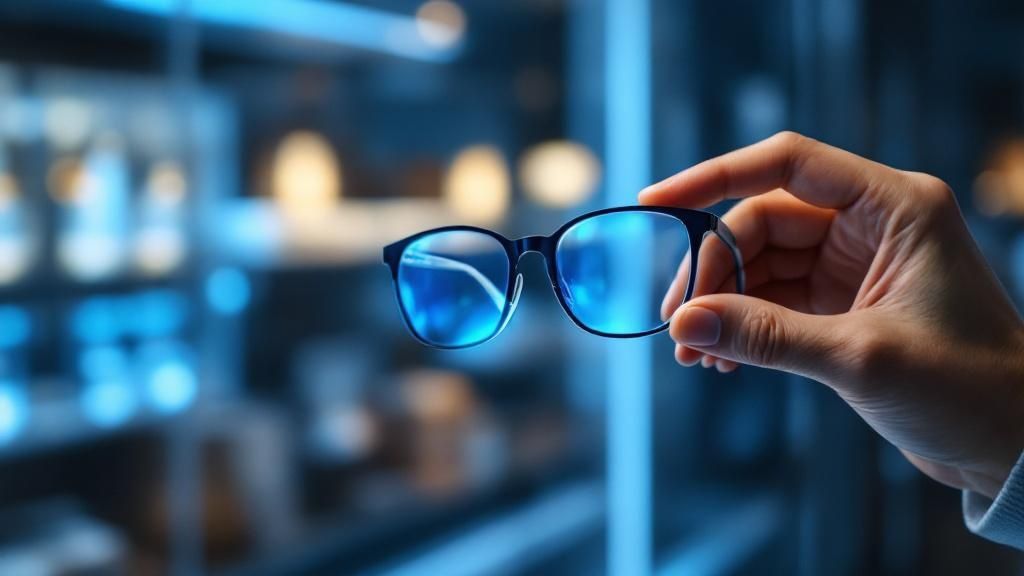
Blue Light Filter Glasses: Protect Your Eyes & Sleep Better
So, are blue light filter glasses actually worth the investment? The short answer is a resounding yes—especially if you spend a good chunk of your day staring at a screen. Think of them as a selective shield, filtering out the harshest light that wears out your eyes and messes with your internal clock.
Are Blue Light Glasses Worth It?

That tired, gritty feeling your eyes get after a long day in front of the computer is something almost every professional and student knows all too well. This sensation, often lumped together as digital eye strain, is largely caused by the high-energy visible (HEV) blue light pouring out of our devices.
This is exactly what blue light filter glasses are designed to fight. You can think of them as a personal bodyguard for your eyes. The specialized lenses are engineered to absorb or reflect a significant portion of this intense blue light before it ever gets a chance to hit your retina. It's a simple idea, but one that can make a huge difference in your daily comfort.
To get a clearer picture of how these glasses can help, let's break down the core benefits.
The Key Benefits
The perks of wearing blue light blocking glasses go beyond just making your eyes feel better in the moment. When you make them part of your daily routine, you'll likely notice a few positive changes:
- Less Digital Eye Strain: They directly tackle common symptoms like dry eyes, headaches, and that frustrating blurred vision that creeps in after hours of screen time.
- Better Sleep: Wearing them in the hours before bed helps your body produce melatonin—the sleep hormone—on a more natural schedule. This is key for a healthier, more consistent sleep cycle.
- More Visual Comfort: By cutting down on glare and harsh light, these glasses simply make looking at screens for long stretches a much more pleasant experience.
At their heart, blue light filter glasses give you back some control. They let you manage your light exposure, which in turn helps you manage how screens impact both your eyes and your sleep.
This isn't just a niche idea anymore; people are catching on. The global market for blue light filter glasses was valued at around USD 1.2 billion in 2023. That number is expected to more than double, potentially reaching USD 2.5 to 2.8 billion by 2025, a clear sign of just how much we're all relying on our digital devices. You can dive deeper into these market trends in this detailed report from dataintelo.com.
Here's a quick summary of what we've covered to help you decide if they're right for you.
Blue Light Filter Glasses At a Glance
The table below breaks down the essentials of blue light glasses—what they do, why it matters, and what to keep in mind.
| Aspect | Key Takeaway |
|---|---|
| Primary Function | To filter a portion of high-energy visible (HEV) blue light from digital screens. |
| Main Benefit | Reduces digital eye strain, including symptoms like dry eyes, headaches, and blurriness. |
| Sleep Impact | Helps regulate melatonin production for a healthier, more natural sleep-wake cycle. |
| Who Needs Them? | Anyone who spends significant time in front of computers, phones, or tablets. |
| Key Consideration | Look for glasses that specify the percentage of blue light they block for effectiveness. |
Ultimately, choosing to wear blue light glasses is a practical step toward greater comfort in our screen-filled world. By understanding how they work and what to look for, you can make an informed choice that benefits both your productivity and your well-being.
Understanding the Problem of Blue Light

To really get why blue light filter glasses work so well, we first need to understand the problem they’re built to solve. Think of the light you can see as a rainbow, stretching from the gentle, low-energy red light on one end all the way to the high-energy violet light on the other. Blue light is right next to violet and the invisible (but powerful) UV rays, meaning it packs more of an energetic punch than other colors like green or yellow.
Now, not all blue light is the enemy. Our bodies actually depend on the natural blue light we get from the sun. When the sun is up, this light acts as a crucial signal for our internal clock—our circadian rhythm—telling our brain it's time to be awake, alert, and focused. It’s a vital part of what regulates our energy and mood throughout the day.
The real issue isn't the light itself, but the source and timing of our exposure.
The Rise of Artificial Blue Light
The modern challenge we all face is the constant flood of artificial blue light from our digital devices. Laptops, smartphones, tablets, and even those energy-efficient LED bulbs in our homes are all pumping out significant amounts of it. So, long after the sun has set and natural blue light has faded, our screens are still shining brightly, often right in our faces.
This nonstop, late-night exposure sends a deeply confusing message to your brain. It's basically tricking your body into thinking it's still the middle of the day, which throws a wrench into some pretty important biological gears. The most significant process it disrupts is the production of melatonin, the hormone that tells your body it's time to wind down and sleep.
When your brain sees blue light after dark, it’s like a factory manager telling the night shift to go home just as they’re clocking in. Your body’s natural sleep preparations get completely thrown off schedule.
From Disruption to Digital Eye Strain
This constant mismatch is a huge driver of what we call digital eye strain. It’s that feeling we all know too well—a collection of uncomfortable symptoms that crop up after staring at a screen for too long.
So what does this feel like in the real world?
- Dry, Itchy, or Watery Eyes: Staring at screens often means we blink less, and blue light can make that worse, leaving your eyes feeling tired and irritated.
- Headaches and Migraines: For some people, the high energy of blue light is a known trigger for tension headaches and can make migraines even more intense.
- Blurred Vision: After hours of focusing on a screen, your eyes can struggle to adjust, leading to that temporary fuzzy feeling.
- Trouble Falling Asleep: By holding back melatonin production, late-night screen time can make it much harder to fall asleep and get the deep, restorative rest you need.
The science behind these effects isn't just theory; it's well-documented. Study after study shows clear links between our exposure to artificial light, the comfort of our eyes, and our sleep patterns. For anyone who wants to dive deeper, there are plenty of detailed blue light studies and informational resources available to explore.
At the end of the day, the problem goes beyond just tired eyes. It’s about how our modern habits are clashing with a biological system our bodies have relied on for thousands of years. Blue light filtering glasses offer a simple, practical tool to help bring some of that natural balance back.
How Blue Light Glasses Filter What You See
So, what’s actually happening behind the lenses of these glasses to protect your eyes? The tech is a lot more straightforward than you might think. Imagine blue light filter glasses are like a sophisticated strainer for light—they’re designed to let all the good, gentle light through while catching the harsh, high-energy stuff that makes your eyes feel fried after a long day.
This filtering happens in one of two main ways.
Many glasses have a special coating applied right onto the surface of the lens. This coating works like a tiny, very selective mirror, bouncing a specific portion of the most intense blue light wavelengths away before they ever get a chance to hit your eye. You can usually tell if glasses use this method by tilting them in the light—you'll often see a faint blue or purple shimmer.
The other common technique builds the filter directly into the lens material itself. Here, special pigments are blended into the polymer that forms the lens when it's made. Instead of reflecting the light, these pigments are engineered to absorb a slice of the blue light spectrum. This method typically gives the lenses a very subtle, warm hue, most often a faint yellow or amber color.
Daytime Comfort vs. Nighttime Protection
That slight tint isn't just for looks; it's a huge clue about what the glasses are designed to do. The best blue light glasses are tailored for specific times of the day, primarily splitting their duties between daytime work and nighttime winding down.
-
Daytime Glasses (Clear or Lightly Tinted): These are your workhorses. They’re made to combat digital eye strain and cut down on that annoying screen glare during your 9-to-5. They filter a targeted amount of blue light—usually around 30-50%—enough to take the harsh edge off without messing with your color perception. This makes them perfect for designers, office workers, or anyone who relies on seeing true-to-life colors.
-
Nighttime Glasses (Amber or Red Tinted): These glasses have a completely different mission: to guard your sleep. They block a much higher percentage of blue light, often 90% or more, to stop your screens from tricking your brain into thinking it's still daytime. This keeps your body's melatonin production on track. That darker amber or red tint is a sure sign of heavy-duty protection, making these ideal for late-night work sessions or scrolling before bed.
This infographic does a great job of connecting the dots between filtering blue light and the real-world results you can feel.

As you can see, by managing the type of light that reaches your eyes, these glasses can directly lead to more comfortable eyes and healthier sleep patterns, which naturally helps you feel more focused. Figuring out which type of filtration you need—a reflective coating for daytime clarity or absorptive pigments for nighttime protection—is the key to getting the benefits you’re after.
Real-World Benefits for Your Eyes and Sleep

Let's move past the technical side of things and talk about what you can actually feel. The perks of wearing blue light filter glasses really boil down to two main areas: immediate relief for your eyes and, over the long haul, much better sleep. It’s all about feeling better during your workday and long after you’ve shut your laptop.
The first thing most people notice is a sharp decline in digital eye strain. Your eye muscles are in a constant state of flex, trying to focus on bright, pixelated screens for hours on end. Filtering out that harsh, high-energy light is like letting those muscles finally relax, easing the tension that builds up throughout the day.
This reduction in eye fatigue often brings other welcome changes. Many people who had just accepted daily headaches or that gritty, dry-eye feeling as part of a screen-heavy job find themselves feeling surprisingly good. It’s the difference between clocking out with a pounding headache and finishing your work feeling clear-headed.
Protecting Your Natural Sleep Cycle
While feeling better during the day is a huge win, the real magic happens in the evening. Slipping on a pair of blue light glasses after sunset helps your body’s internal clock, or circadian rhythm, get back on track. By blocking the artificial blue light that tells your brain to stay awake, you’re allowing it to get the natural signal that it’s time to wind down.
This simple habit can create a powerful ripple effect on your entire nightly routine.
When you stop screens from messing with your circadian rhythm, you're not just making it easier to fall asleep. You're setting the stage for a more consistent and deeply restorative sleep cycle, night after night.
Think of a graphic designer who starts wearing amber-tinted glasses for the last couple of hours of their workday. Before, they’d often lie in bed for an hour, mind still buzzing from the screen's glow. Now, it's a different story. They start feeling sleepy at a regular time, drift off faster, and wake up feeling genuinely rested. We hear stories like this all the time. To dive deeper, check out our post on how anti-blue light glasses help you sleep better.
The market is catching on. The prescription blue light blocking glasses market is on track to become a USD 2.5 billion industry worldwide by 2025, and it’s not slowing down. This growth is driven by everyday people looking for a practical fix for their screen-filled lives.
Of course, managing light exposure is just one part of the equation. Pairing blue light glasses with other smart strategies for achieving restorative sleep can make a world of difference. When you combine smart light management with good sleep habits, you give yourself the best possible shot at a great night's rest.
Choosing the Right Pair for Your Lifestyle
Not all blue light glasses are created equal. Far from it. The pair that saves a graphic designer from midday headaches might be the completely wrong choice for a late-night reader trying to protect their sleep. The secret is finding the right lens technology for your life.
Think of it like choosing tires for your car. You wouldn't put slick racing slicks on an off-road truck heading into the mountains. In the same way, you need to match your glasses to the “terrain” of your day—whether that’s an eight-hour shift in a brightly lit office or a cozy evening scrolling on your tablet.
The biggest difference between glasses comes down to one thing: how much blue light they're built to block.
Filtration Level for Day or Night
The lens tint is your first and most important clue. It tells you exactly what the glasses are designed for. Your choice here depends entirely on when you plan to wear them and what problem you're trying to solve.
-
For Daytime Use (Clear or Light-Tint Lenses): If your main enemy is digital eye strain, computer-induced headaches, and that general fried-eye feeling after a long day, you want a pair with clear or very lightly tinted lenses. These glasses typically filter between 30-50% of blue light. That’s the sweet spot for taking the harsh, high-energy edge off screens without messing up your color perception. This makes them perfect for work where seeing true-to-life color is non-negotiable, like photo or video editing.
-
For Evening and Nighttime Use (Amber or Red Lenses): Now, if your primary goal is to protect your natural sleep cycle, you need to bring out the heavy artillery. Darker amber or red-tinted lenses are designed to block 90% or more of blue and even some green light. This aggressive approach is essential for stopping artificial light from slamming the brakes on your body’s melatonin production—the very hormone that tells your brain it’s time to wind down.
Here's a simple rule of thumb: The clearer the lens, the better it is for daytime focus and fighting eye strain. The darker and more orange or red the lens, the more powerfully it guards your sleep.
Lens Quality and Frame Comfort
Beyond the tint, the quality of the lenses and frame can make or break your experience. Cheap, poorly made lenses can introduce glare, smudges, and weird distortions that just swap one kind of eye discomfort for another.
As you shop for your perfect pair, keep an eye out for these critical features:
- Anti-Glare (AR) Coating: This is non-negotiable. An anti-reflective coating cuts down on those distracting reflections bouncing off both the front and back of your lenses, giving you a much clearer and less annoying view.
- Scratch-Resistant Coating: You're going to be wearing these a lot, so a tough, scratch-resistant coating is a must to keep your vision crisp and get your money's worth.
- Frame Fit and Style: Comfort is king. If your glasses pinch your nose, squeeze your temples, or just feel heavy, they're destined to live in a desk drawer. Look for lightweight materials and a style you actually feel good wearing.
Finally, think about your own vision needs. If you already wear prescription glasses, you can get blue light filter glasses built with your exact prescription. While a good pair of non-prescription "readers" works wonders for many, investing in a prescription pair from your optometrist ensures your vision is perfectly corrected while getting that blue light protection. It’s the best of both worlds: comfortable eyes and crystal-clear sight.
Thinking about getting a pair of blue light filter glasses? You're definitely not alone. This isn't some fleeting wellness fad; it's a huge global health movement, all thanks to our ever-present digital screens. The worry over digital eye strain has kicked off a worldwide scramble for protective eyewear, turning what feels like a personal choice into a major international market.
This wave of awareness is changing how people look at eye care from one continent to another. It shows that shielding our eyes from screens is fast becoming a universal concern. The market data really drives this home, painting a clear picture of this collective shift. This demand isn't just popping up in one place—it's booming everywhere from North America to Europe and Asia, with every region seeing some serious growth.
A Worldwide Health Priority
This global trend really just confirms what most of us already feel after a long day of staring at screens—that tired, strained sensation in our eyes. It points to a shared understanding that our modern lives need modern solutions. Just a quick look at the market figures shows how widespread this movement has become.
The global demand for blue light protection isn't just about feeling a bit more comfortable. It's a huge shift in public health awareness. People are actively looking for tools to push back against the side effects of a screen-heavy life.
Looking ahead to 2025, market projections show the Asia Pacific region is leading the pack, expected to grab about 32.23% of the global market share. That's a value of roughly $589.5 million. Europe is right on its heels, making up 26.65% of the market. Its value is projected to climb from $304 million in 2021 to an impressive $487.5 million by 2025. If you want to dive deeper into the numbers, you can check out more details on these trends in this market report from Cognitive Market Research.
Frequently Asked Questions About Blue Light Glasses
As more people talk about screen time and how it affects our eyes, the questions start piling up. It's totally understandable. Let's clear up some of the most common uncertainties about blue light filter glasses with some straight-to-the-point, practical answers.
Can You Wear Blue Light Glasses All Day?
You certainly can, but whether you should really comes down to the type of lens you have.
For everyday use, those clear or lightly tinted daytime glasses are perfectly fine to wear from morning 'til night. They’re designed to cut down on screen glare and take the harsh edge off artificial light without messing with your color perception. This makes them a great choice for the office or just general screen use.
On the other hand, those darker amber or red-tinted lenses are a different story. They're best kept for evening use only. If you wear these heavy-duty filters during the day, you risk blocking the natural blue light your body actually needs to feel awake and keep its internal clock on track. Think of them as your pre-bedtime tool and save them for the last couple of hours before you hit the hay.
Are Expensive Blue Light Glasses Better?
Not always, but the price tag can often give you a hint about the quality of the lenses and how durable the frames are. You definitely don't need to shell out for the most expensive pair you can find.
However, spending a little more often gets you some really crucial features. A big one is a high-quality anti-reflective (AR) coating, which is a game-changer for preventing that distracting glare bouncing off your lenses. Cheaper glasses often skip this, which can ironically lead to more eye strain.
The goal is to find a good balance. A solid pair from a brand that knows what it's doing will give you effective filtration and a sturdy frame without costing a fortune.
The most important factor isn't the price tag itself, but what you get for it. Focus on certified filtration levels and features like an anti-glare coating over brand name alone.
Do Blue Light Filter Glasses Work for Everyone?
For the most part, yes. Pretty much anyone who logs serious hours in front of a digital screen can feel some kind of relief from symptoms like tired eyes, headaches, or blurry vision.
How much of a difference you'll feel can vary. It often depends on your own sensitivity to light and just how much time you're spending on your devices.
People who are especially prone to migraines or just have naturally sensitive eyes often tell us they notice the most dramatic improvements. Similarly, if you've been struggling to get to sleep, using amber lenses at night can be a real game-changer. If you want to dig deeper, you can explore more on the benefits of blue light glasses and see how they fit different lifestyles.
Are There Any Side Effects or Risks?
For the vast majority of people, blue light glasses are completely safe and come with no negative side effects.
The only potential hiccup is wearing heavily tinted nighttime glasses during the day. Since they block the energizing blue light your brain expects when the sun is up, you might find yourself feeling a bit drowsy.
It really just comes down to using the right tool for the job: lightly tinted lenses for daytime focus and darker lenses to help you wind down at night. When you use them as intended, they’re a perfectly safe and effective way to manage your light exposure.
Ready to give your eyes the protection they deserve? Spektrum Glasses offers a premium collection of science-backed blue light glasses designed for ultimate comfort and visual clarity. Find your perfect pair and see the difference at spektrumglasses.com.
Article created using Outrank
